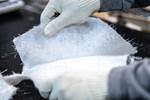High-velocity fan technology for fiberglass dust cleanup
CAMX 2024: SonicAire presents dust-control fans to simplify dust cleanup in fiberglass facilities using its high-velocity BarrierAire technology.

Source | SonicAire
(Winston-Salem, N.C., U.S.) is presenting NFPA-compliant solutions in the form of its proprietary BarrierAire fan technology, engineered to automate overhead housekeeping, control combustible dust buildup and eliminate the need for manual dust cleanup in fiberglass facilities.
The dust control fans are specifically designed to prevent dust from settling in hard-to-reach areas. Their high-velocity airflow prevent combustible fiberglass dust particles from settling on overhead structures, which can improve facility safety. In addition, thermal current control helps prevent dust buildup in inaccessible areas prone to fire and explosion risks.
Fully automated, SonicAire fugitive dust management simplifies the task of maintaining cleanliness and safety in fiberglass facilities. This not also eliminates the need to schedule weekend work, extend business hours or halt production for cleaning purposes.
Various SonicAire fan options are available, including:
- Pro Series: For typical fiberglass environments.
- Extreme Series: For harsh fiberglass manufacturing environments, including the only dust control fan certified for Class II, Div. 1 hazardous locations.
- Specialty Series: For custom fiberglass applications.
- Command Series: Customizable fan control systems for optimal operation in each fiberglass setting.
In addition, SonicAire provides complimentary dust management plans and ROI analysis. Its engineering team will create a tailored analysis demonstrating how SonicAire fans can minimize combustible dust buildup, enhance worker safety and productivity, and provide compliance with OSHA regulations. The team will also deliver an ROI analysis outlining long-term cost savings.
Related Content
-
ZEBRA project demonstrates closed-loop wind recycling system
Consortium partners have proven the complete recycling of thermoplastic wind turbines via two manufactured wind blades, featuring reduced operating cost, CO2 emissions.
-
Thermoplastic composite pipes provide 59% reduction in H2 distribution CO2 emissions
Hive Composites’ multilayer thermoplastic composite pipe (TPC) design meets hydrogen permeation requirements while ensuring substantial CO2 reductions compared to conventional steel pipe systems.
-
PUR composite sandwich panels for 3D automotive parts, high-volume panels and more
At its U.S. sites, Ascorium produces glass fiber/PUR 3D parts via semi-automated molding, high-volume flat panels via a continuous line while working toward bio-based PUR and recycling.




